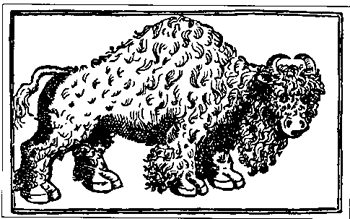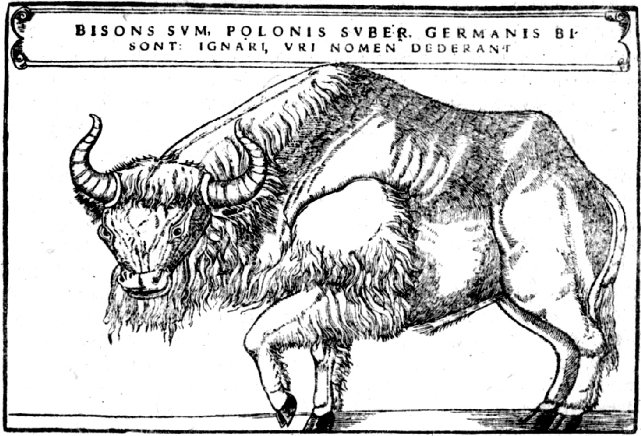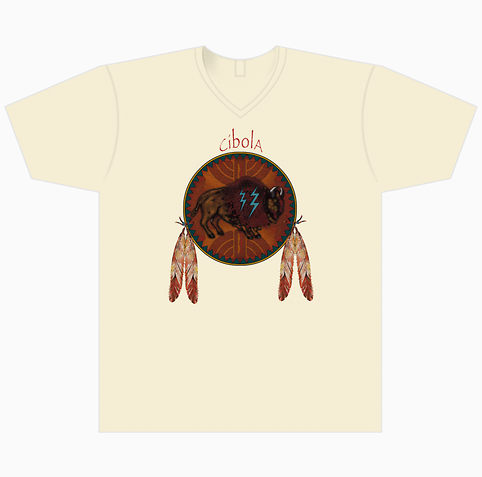In Search Of The Cibola
Posted by: Loren Coleman on October 26th, 2008
There needs to be a check of the region south of Hachita, New Mexico, USA, in the northern Chihuahuan Desert, for the reported survival of a third (?) species of Bison, according to Cryptomundo correspondent Ann U.
Once known by the Conquistadors as the “Cibola,” it was said to be extremely wisent-like. Reportedly, it is now “thought” to be extinct. There have been more than just a few credible sighting since the 1990s. One was by a Forest Service employee.
Spanish explorers in North America who first saw the shaggy bovine called it Cibola, which was also their name for the general region where they saw it: the seven pueblos in today’s northern New Mexico–the fabled Seven Cities of Cibola. Other Spaniards called it bisonte, said to be related to the Old Teutonic word wisand, or the Old English wesend.
The Governor of Mexico City listened to an Indian slave named Tejo recount tales of trading expeditions that he and his father had taken for years. He also claimed that during his travels with his father, they had seen seven cities where gold and silver were used in every day life for jewelry and decorating homes. That is what started the quest for the Seven Cities of Gold or Cibola (map, below).
When Juan Oñate, the first governor of New Mexico, initially encountered the Apache on the Southern Plains, he described them as people:
…who live in tents of tanned hides among the herds of Cibola [bison]. The Apiches [sic Apaches} are infinite in number….They live in rancherias, and from the few days I spent in their area, I have discovered they live like the people who live in pueblos. One [rancheria] located about 18 leagues from here has 15 plazas [presumably, he meant 15 extended family groups].
Tee-shirt by Sena.
[The term “cibola” is not to be confused with “chibola,” which is a Peruvian slang term for “chica” (“girl”), “nena” (“baby”), and “bebe” (“sexy woman”).]
About Loren Coleman
Loren Coleman is one of the world’s leading cryptozoologists, some say “the” leading living cryptozoologist. Certainly, he is acknowledged as the current living American researcher and writer who has most popularized cryptozoology in the late 20th and early 21st centuries.
Starting his fieldwork and investigations in 1960, after traveling and trekking extensively in pursuit of cryptozoological mysteries, Coleman began writing to share his experiences in 1969. An honorary member of Ivan T. Sanderson’s Society for the Investigation of the Unexplained in the 1970s, Coleman has been bestowed with similar honorary memberships of the North Idaho College Cryptozoology Club in 1983, and in subsequent years, that of the British Columbia Scientific Cryptozoology Club, CryptoSafari International, and other international organizations. He was also a Life Member and Benefactor of the International Society of Cryptozoology (now-defunct).
Loren Coleman’s daily blog, as a member of the Cryptomundo Team, served as an ongoing avenue of communication for the ever-growing body of cryptozoo news from 2005 through 2013. He returned as an infrequent contributor beginning Halloween week of 2015.
Coleman is the founder in 2003, and current director of the International Cryptozoology Museum in Portland, Maine.














The old picture from 1556 was actually quite important, because it proved the former existence of the aurochs. It was drawn (or better said cutted in wood) by Augustin Hirsfogel. For a long time it was thought that the wisent and the aurochs were the same animal, and only comparably recently in the 19th century it was discovered that there were once two different species of wild cattle in European woods.
You can also find a nearly identical picture of the wisent in Conrad Gesner’s Historia Animalium.
I live in El Paso and have worked around Hachita. On the west side of the Hachet Mountains there is a herd of bison. They range between New Mexico and Mexico. If you travel between Hachita and Antelope Wells you can sometimes see them. There are bison crossing signs on the road. The herd is numerous enough for hunting which can be arranged on some of the private ranches in the area.
It would be of great interest if there was another bison but this is a new idea for me and I am rather confused about what evidence there may be and the local geography etc. Are plains bison being bred and commercially exploited in the area mentioned and are they roaming ? Are there groups who seek out the evidence of any new bison ? If anyone can offer more imformation or a source I would appreciate it. (Maybe Ann unknown knows ?)
I note the two woodcuts above are both of the wisent. There is another similar woodcut elsewhere of an auroch, but looking very domestic cattle like !
Are there hugh unexploited areas in mexico where new animals or variants can exist and if there is forests there will be bigfoot !
A new species of bison would certainly be exciting, however could they not be very Southern ranging populations of the known American bison? I am not sure what exactly the evidence is that it is a whole new species we are talking about here.
There is precedent for the American bison in Mexico. Not only do archeological records show that the historic range of the American bison reached into Northern Mexico, there is also a herd of Bison that can be found in Mexico to this day. The Janos-Hidalgo herd, which is the southernmost known herd of bison, have been moving between Chihuahua, Mexico and New Mexico in the United States for decades. These are not a new species, but a herd of the known North American species, so bison are already known in Mexico. Perhaps these animals or another similar herd are what is being reported? Maybe there are undiscovered herds that are even more Southern as well? The fact that the Janos-Hildago herd have prospered in such a dry environment suggests to me that the bison is capable of adapting to those conditions.
I am not convinced we are looking at a totally new species here.
jrenn- Incidentally, the herd I mentioned is the one that you saw. They have been moving between Mexico and the States since at least the 1920s, and as I said they are the Southernmost free ranging herd of bison that is known.
Norman-uk- Perhaps my post answered some of your questions. As far as the geography of where the Janos-Hildago herd are found, it is dry, desert grassland and scrubland. Very dry conditions for bison, and this is the only herd found in such conditions, but there they are and they are doing quite well. It is apparent that they can adapt to live in that environment, and the bison was once in even more Southern locales.
This all leads me to think that the animal in question is perhaps just the known American bison. That or maybe a subspecies that has developed certain traits to adapt to the desert conditions.
Yes, norman-uk, this is exactly what I am wondering about, as well.
The vast areas east of the Sierras, in Old Mexico, may be as close to a “lost world” as I think you may find on this North American continent. However, it is not renown as a “tourist friendly” area; it’s greatest strength (preservation) and it’s greatest danger (exploration). Even many of the features on most road maps of the bordering, southern part of New Mexico, in the USA, were only recently listed: the Peloncillo Mts, the Animas Mts, the Pyramid Mts … . My old, 1990 road map shows this as a blank.
What little I know about the bison, was informally gleaned (road trip, 2005) from various residents in the northern area of Hidalgo County, New Mexico, USA. The animals were said to have first been observed coming across the border in the 1980s by border ranchers. The people in the area described them as looking distinctly different from the more northern plains populations: less woolly, almost lacking the characteristic hump of their plains relatives, leaner, and much smaller (“miniature” or “half the weight of a plains bison”). From what I was told, this is supposed to more closely resemble the animals described by the early Spanish explorers near Mexico City, in the 1500s.
It is difficult to say whether this is a recent adaptation by a population that has been geography isolated in an extreme desert environment for generations, or an entirly different species that has been indigenous to a remote part of Mexico for eons.
I would really like to know. 🙂
“The Apiches [sic Apaches} are infinite in number….They live in rancherias, and from the few days I spent in their area, I have discovered they live like the people who live in pueblos. One [rancheria] located about 18 leagues from here has 15 plazas [presumably, he meant 15 extended family groups].”
Or he could have been referring to what was once known as Panhandle Pueblo culture (now more often termed “slab house people”) who ranged throughout the Texas and Oklahoma Panhandles and perhaps even into Kansas and Nebraska.
What made them unique is they seemed to be a transitional culture, bridging the plains tribes with those of the Pueblos. They had characteristics of each and evidence located at several digs proves they did trade in pottery and pelts with other tribes further to the east and west.
Their architecture was very Puebloan in design. They built adobe roomblock structures that may have had granaries and circular kiva-like structures.
If it is a new species well done. 🙂
i think that not all animals we think are extinct actually went extinct. Perhaps a small number, let’s say 2 or 10 for example, survived in the wild and then reproduced. They were hidden because they knew they were going to die from bigger predators, so these animals’ instincts kick in to hide them. They adapted to living in hiding and therefore we can’t find them.
As for larger animals, same thing; they reproduce and were normally hidden in the past and now. That is untill one of them is wanders into the open and we see them.
I read from the site ingentaconnect searching under ”mexican bison” that the Janos-hildalgo herd were formed at the turn of the century (1900) from various sources and have been free ranging between Mexico and the US.since 1920. I wonder what the sources were and did they include a different bison, maybe wisent like ? The inference from reports that there is a different type of bison in this area, would not be surprising given the impetus to seperate development suggeted by a variety of terrain. More imformation would be nice but seems hard to come by-maybe not for a local ?